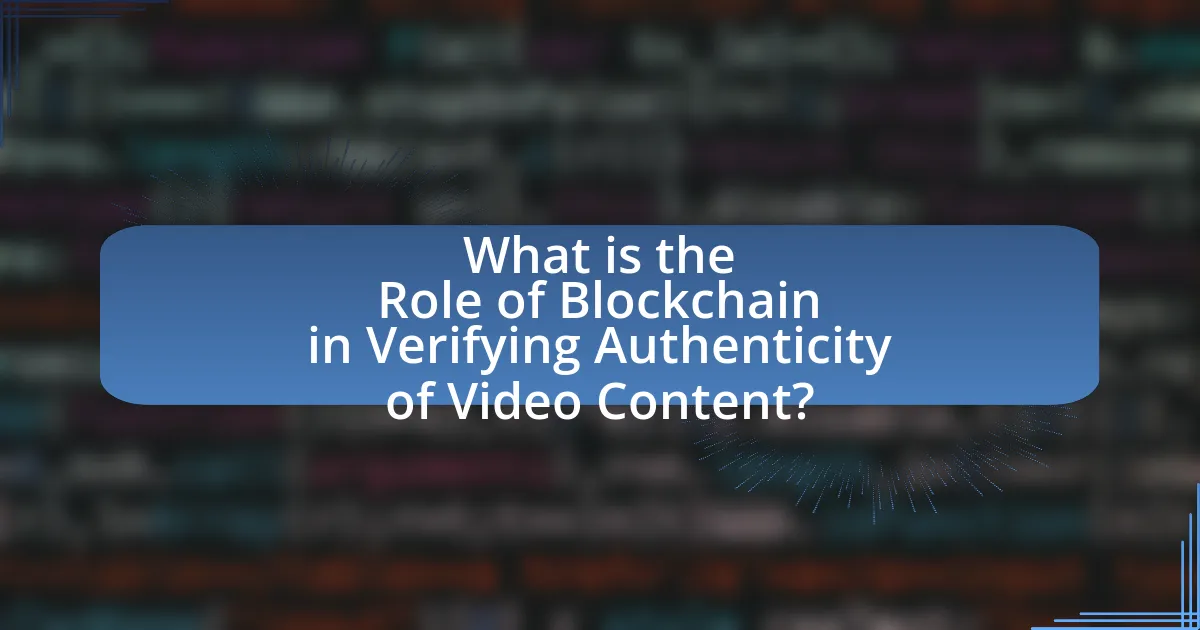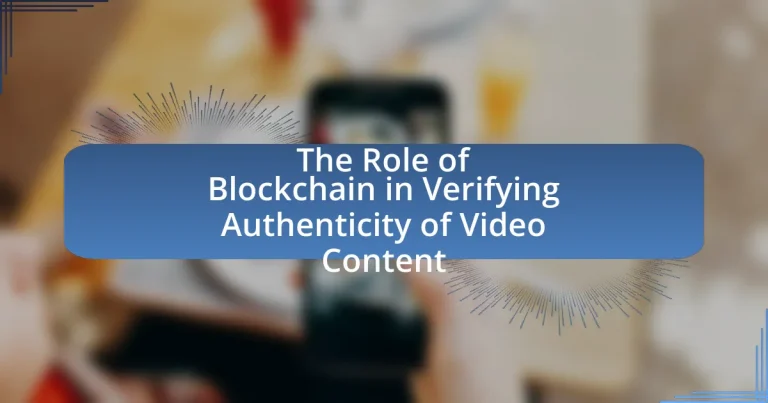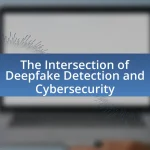The main entity of the article is blockchain technology and its application in verifying the authenticity of video content. The article outlines how blockchain provides a decentralized and immutable ledger that records every transaction related to video files, ensuring their integrity and preventing tampering. Key features such as immutability, transparency, and decentralization enhance trust in digital media by allowing users to trace the origin and modifications of videos. It also discusses the importance of verifying video authenticity to combat misinformation, the risks associated with unverified content, and the challenges blockchain faces in scalability and integration with existing systems. Additionally, the article compares blockchain with traditional verification methods, highlights future prospects, and suggests best practices for implementation.

What is the Role of Blockchain in Verifying Authenticity of Video Content?
Blockchain plays a crucial role in verifying the authenticity of video content by providing a decentralized and immutable ledger that records every transaction related to the video. This technology ensures that any changes made to the video can be traced back to their origin, thereby preventing tampering and unauthorized alterations. For instance, when a video is uploaded to a blockchain platform, its unique hash is created and stored on the blockchain, allowing users to verify its integrity at any time. This method has been validated by various studies, including research from the University of California, which highlights how blockchain can enhance trust in digital media by ensuring provenance and authenticity.
How does blockchain technology contribute to video content verification?
Blockchain technology enhances video content verification by providing a decentralized and immutable ledger that records every transaction related to the video. This ensures that the origin, modifications, and distribution of the video can be traced back to its source, thereby confirming its authenticity. For instance, when a video is uploaded, its hash is created and stored on the blockchain, making it nearly impossible to alter without detection. This method has been utilized in various applications, such as verifying news footage and preventing the spread of misinformation, as evidenced by projects like Po.et and Everledger, which focus on content provenance and ownership verification.
What are the key features of blockchain that enhance video authenticity?
The key features of blockchain that enhance video authenticity include immutability, transparency, and decentralization. Immutability ensures that once a video is recorded on the blockchain, it cannot be altered or deleted, providing a permanent record of the content. Transparency allows all participants in the network to verify the authenticity of the video through a shared ledger, making it easy to trace the origin and modifications of the content. Decentralization eliminates the need for a central authority, reducing the risk of manipulation or fraud by distributing control across multiple nodes. These features collectively ensure that video content remains trustworthy and verifiable, as supported by the inherent characteristics of blockchain technology.
How does decentralization play a role in verifying video content?
Decentralization enhances the verification of video content by distributing the storage and validation processes across multiple nodes in a network, reducing the risk of manipulation. This structure allows for a transparent and immutable ledger, where each video file can be timestamped and linked to its original source, ensuring authenticity. For instance, blockchain technology enables users to trace the history of a video, confirming its origin and any alterations made over time. This method has been validated by various studies, including a 2020 report from the International Journal of Information Management, which highlights that decentralized systems significantly improve trust in digital content by providing verifiable proof of authenticity.
Why is verifying the authenticity of video content important?
Verifying the authenticity of video content is crucial to prevent misinformation and maintain trust in media. Authentic videos can influence public opinion, inform decision-making, and uphold journalistic integrity. For instance, a study by the Pew Research Center found that 64% of Americans believe fabricated news stories cause confusion about basic facts. This highlights the need for reliable verification methods to distinguish genuine content from manipulated or misleading videos.
What are the risks associated with unverified video content?
Unverified video content poses significant risks, including the spread of misinformation, manipulation of public perception, and potential legal consequences. Misinformation can lead to public panic or misinformed decisions, as seen during events like the COVID-19 pandemic, where unverified videos contributed to widespread confusion about health guidelines. Manipulation of public perception occurs when videos are edited or taken out of context, influencing opinions on critical issues, such as elections or social movements. Additionally, individuals or organizations sharing unverified content may face legal repercussions for defamation or copyright infringement, as demonstrated by various lawsuits against media outlets for broadcasting unverified claims. These risks highlight the importance of verifying video content to maintain accuracy and trust in information dissemination.
How can authenticity verification impact trust in media?
Authenticity verification significantly enhances trust in media by ensuring that content is genuine and unaltered. When media organizations implement authenticity verification methods, such as blockchain technology, they provide a transparent and immutable record of content creation and modifications. This transparency allows consumers to verify the source and integrity of the media they consume, thereby reducing the likelihood of misinformation. For instance, a study by the Pew Research Center found that 64% of Americans believe that fabricated news stories cause confusion about the facts, highlighting the need for reliable verification methods. By establishing a trustworthy framework for content verification, media outlets can foster greater audience confidence and engagement.
What challenges does blockchain face in video content verification?
Blockchain faces several challenges in video content verification, primarily including scalability, data privacy, and the complexity of integration with existing systems. Scalability issues arise because blockchain networks can struggle to handle the high volume of data generated by video content, leading to slower transaction times and increased costs. Data privacy concerns are significant, as storing sensitive video information on a public blockchain can expose it to unauthorized access. Additionally, the integration of blockchain technology with current video distribution and verification systems can be complex, requiring significant changes to existing workflows and infrastructure. These challenges hinder the widespread adoption of blockchain for video content verification.
What are the technical limitations of using blockchain for video verification?
The technical limitations of using blockchain for video verification include scalability issues, high storage requirements, and latency in transaction processing. Scalability is a concern because most blockchain networks struggle to handle a large volume of transactions simultaneously, which can hinder the verification of numerous video files in real-time. High storage requirements arise from the need to store large video files or their hashes on the blockchain, leading to increased costs and inefficiencies. Additionally, latency in transaction processing can delay the verification process, as blocks must be mined or validated before the video data can be confirmed, making it unsuitable for applications requiring immediate verification. These limitations highlight the challenges of integrating blockchain technology effectively for video verification purposes.
How do scalability issues affect blockchain’s effectiveness in this area?
Scalability issues significantly hinder blockchain’s effectiveness in verifying the authenticity of video content by limiting transaction throughput and increasing latency. For instance, many blockchain networks can only process a limited number of transactions per second, which can lead to delays in recording and verifying video data. This limitation is critical in scenarios requiring real-time verification, such as live streaming or rapid content distribution. According to a study by the Ethereum Foundation, Ethereum can handle approximately 30 transactions per second, which is insufficient for high-demand applications like video verification. Consequently, scalability challenges can result in bottlenecks, reducing the reliability and speed of authenticity checks, ultimately undermining the technology’s utility in this area.
How does blockchain compare to traditional methods of video verification?
Blockchain offers a more secure and tamper-proof method of video verification compared to traditional methods. Traditional video verification often relies on centralized systems, which can be vulnerable to hacking and manipulation, whereas blockchain utilizes a decentralized ledger that records every transaction in an immutable manner. This means that once a video is verified and recorded on the blockchain, it cannot be altered without consensus from the network, ensuring the integrity of the content. Additionally, blockchain provides transparent audit trails, allowing users to trace the history of the video and verify its authenticity easily, which is often not possible with traditional methods that lack such transparency.
What are the advantages of using blockchain over conventional verification methods?
Blockchain offers enhanced security, transparency, and immutability compared to conventional verification methods. Unlike traditional systems that rely on centralized authorities, blockchain operates on a decentralized network, reducing the risk of single points of failure and fraud. Each transaction is recorded in a tamper-proof ledger, making it nearly impossible to alter past records without consensus from the network. This feature is particularly beneficial in verifying the authenticity of video content, as it ensures that any modifications can be traced and verified. Additionally, blockchain’s transparency allows all participants to access the same information, fostering trust among users. According to a study by the World Economic Forum, blockchain technology can reduce verification costs by up to 30%, demonstrating its efficiency over conventional methods.
In what scenarios might traditional methods still be preferred?
Traditional methods might still be preferred in scenarios where regulatory compliance and established legal frameworks are critical, such as in the broadcasting industry. For instance, traditional methods provide a clear chain of custody and documentation that is often required by law, ensuring accountability and adherence to standards. Additionally, industries with legacy systems, like healthcare or finance, may favor traditional methods due to their familiarity and the extensive training already invested in personnel. These sectors often prioritize stability and proven practices over newer technologies, which may still be in the experimental phase.
What are the future prospects of blockchain in video content verification?
The future prospects of blockchain in video content verification are highly promising due to its ability to provide immutable records and enhance trust in digital media. Blockchain technology can create a decentralized ledger that securely logs every interaction with video content, ensuring that any alterations or manipulations are easily traceable. This capability is particularly relevant as concerns about deepfakes and misinformation grow; a study by the MIT Media Lab highlights that blockchain can help authenticate video sources and timestamps, thereby increasing accountability. Furthermore, as major platforms explore blockchain integration, the potential for widespread adoption in content verification becomes more feasible, paving the way for a more transparent media landscape.
How might advancements in blockchain technology improve video verification?
Advancements in blockchain technology can significantly improve video verification by providing a decentralized and immutable ledger for recording video metadata and timestamps. This ensures that once a video is uploaded, its authenticity can be verified through a transparent and tamper-proof system, making it nearly impossible to alter the original content without detection. For instance, blockchain can store cryptographic hashes of video files, allowing users to confirm that the video has not been modified since its initial upload. This method enhances trust in video content, particularly in fields like journalism and legal evidence, where authenticity is crucial.
What trends are emerging in the use of blockchain for media authenticity?
Emerging trends in the use of blockchain for media authenticity include the increasing adoption of decentralized verification systems, the integration of smart contracts for automated rights management, and the development of immutable digital signatures for content provenance. Decentralized verification systems allow multiple stakeholders to validate media content, reducing reliance on single entities and enhancing trust. Smart contracts facilitate automated licensing and distribution processes, ensuring that creators receive fair compensation while maintaining control over their work. Immutable digital signatures provide a reliable method for tracking the origin and modifications of media, thereby combating misinformation and ensuring authenticity. These trends are supported by initiatives from companies like Everledger and IBM, which are actively developing blockchain solutions tailored for media verification.
What best practices should be followed when implementing blockchain for video verification?
When implementing blockchain for video verification, best practices include ensuring data integrity, utilizing decentralized storage, and establishing clear access controls. Data integrity is crucial; blockchain’s immutable ledger guarantees that once video content is recorded, it cannot be altered, thus preserving authenticity. Decentralized storage enhances security by distributing video files across multiple nodes, reducing the risk of single points of failure. Clear access controls must be defined to manage who can upload, view, or modify video content, ensuring that only authorized users can interact with the blockchain. These practices collectively enhance the reliability and trustworthiness of video verification systems.
How can organizations ensure the integrity of their video content using blockchain?
Organizations can ensure the integrity of their video content using blockchain by creating a decentralized ledger that records every transaction related to the video, including its creation, modifications, and distribution. This ledger provides an immutable record, making it nearly impossible to alter or tamper with the video without detection. For instance, platforms like VeChain and IBM’s Food Trust have successfully implemented blockchain to track and verify content authenticity, demonstrating that blockchain technology can effectively safeguard against unauthorized changes and ensure that viewers receive the original, unaltered video.
What tools and platforms are recommended for effective blockchain implementation in video verification?
Recommended tools and platforms for effective blockchain implementation in video verification include Ethereum, Hyperledger Fabric, and VeChain. Ethereum provides a robust smart contract functionality that enables automated verification processes, while Hyperledger Fabric offers a permissioned blockchain framework suitable for enterprise-level applications, ensuring data privacy and security. VeChain specializes in supply chain management and can be utilized for tracking video content authenticity through its unique identification system. These platforms have been validated by numerous case studies demonstrating their effectiveness in securing digital content and ensuring its integrity.


